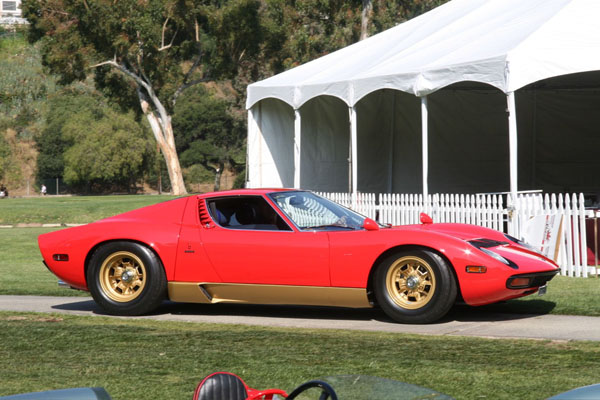Lamborghini presented a credible threat to Ferrari’s supremacy in Italy with cars like the 1966 Miura, with a quad-cam V12 which gave the car a top speed of 275 km/h. This car had a mid-engine layout, but the real advance was that the long V12 engine had been mounted transversely across the frame, the engine block being combined with five-speed all-synchromesh transmission.
With an outstandingly beautiful body style by Bertone, and a name taken up from that of a particularly fearsome breed of Spanish fighting bull, the first complete Miura was unveiled at the Geneva Motor Show. Although it was only intended for a very short production run, it received such a flood of orders that it was destined to become the supercar of the 1960s.
Apart from its general body lines, the Miura was also distinctive because of the way its headlamps lay flush with the bonnet panel, facing the sky when not in use; for the `eyelashes’ below them; and for the slatted rear window. The engine of the original model produced 260kW at 7000rpm, and this edged up even more for the final SV version. The original P400 was somewhat under-developed, and the P400S of 1968 was a much more refined car, with a top speed of nearly 275km/h but with heavy fuel consumption.
All in all 763 Miuras were built in the car’s eight year model life to 1973.
Lamborghini has an interesting history. Ferruccio Lamborghini owned a Ferrari and on one occasion when he met Enzo Ferrari he felt that Ferrari had snubbed him. As a result of this encounter he decided to manufacture sportscars in competition with Ferrari.
Money was no problem as he had already made his fortune manufacturing tractors and industrial heating equipment. He was a true lover of fast cars and had himself competed in the Mille Miglia in 1948. He built a brand new factory at Sant’Agata Bolognese, only 32km from the Ferrari plant at Maranello and then hired two of Ferrari’s most experienced designers to design an engine and a chassis.
Ferrari had always favoured V12 engines in the 1960s and Lamborghini wanted a car design which would compete head to head with Ferrari in every respect. Initially, output from this plant was relatively conventional front engined cars, but distinguished by the magnificent four-cam V12 engine in either the 3.5- or 4.0-litre form. When the Miura was in development the designers saw this as a racing sportscar, but Lamborghini himself would have none of it and demanded that the car should be tamed for road use.
The Miura and its ultimate replacement, the Countach, both from the Lamborghini stable have been included in the Top 100 Cars listing in the Car of the Century survey.
